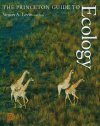About this book
The Princeton Guide to Ecology is a concise, authoritative one-volume reference to the field's major subjects and key concepts. Edited by eminent ecologist Simon Levin, with contributions from an international team of leading ecologists, The Princeton Guide to Ecology contains more than ninety clear, accurate, and up-to-date articles on the most important topics within seven major areas: autecology, population ecology, communities and ecosystems, landscapes and the biosphere, conservation biology, ecosystem services, and biosphere management. Complete with more than 200 illustrations (including sixteen pages in color), a glossary of key terms, a chronology of milestones in the field, suggestions for further reading on each topic, and an index, this is an essential volume for undergraduate and graduate students, research ecologists, scientists in related fields, policymakers, and anyone else with a serious interest in ecology.
Features:
- Explains key topics in one concise and authoritative volume
- Features more than ninety articles written by an international team of leading ecologists
- Contains more than 200 illustrations, including sixteen pages in color
- Includes glossary, chronology, suggestions for further reading, and index
- Covers autecology, population ecology, communities and ecosystems, landscapes and the biosphere, conservation biology, ecosystem services, and biosphere management
Contents
Preface vii
Contributors ix
Part I: Autecology 1
I.1 Ecological Niche 3
I.2 Physiological Ecology: Animals 14
I.3 Physiological Ecology: Plants 20
I.4 Functional Morphology: Muscles, Elastic Mechanisms, and Animal Performance 27
I.5 Habitat Selection 38
I.6 Dispersal 45
I.7 Foraging Behavior 51
I.8 Social Behavior 59
I.9 Phenotypic Plasticity 65
I.10 Life History 72
I.11 Remote Sensing and Geographic Information Systems 79
I.12 Geographic Range 87
I.13 Adaptation 93
I.14 Phenotypic Selection 101
I.15 Population Genetics and Ecology 109
I.16 Phylogenetics and Comparative Methods 117
I.17 Microevolution 126
I.18 Ecological Speciation: Natural Selection and the Formation of New Species 134
I.19 Adaptive Radiation 143
Part II: Population Ecology 153
II.1 Age-Structured and Stage-Structured Population Dynamics 155
II.2 Density Dependence and Single- Species Population Dynamics 166
II.3 Biological Chaos and Complex Dynamics 172
II.4 Metapopulations and Spatial Population Processes 177
II.5 Competition and Coexistence in Plant Communities 186
II.6 Competition and Coexistence in Animal Communities 196
II.7 Predator-Prey Interactions 202
II.8 Host-Parasitoid Interactions 213
II.9 Ecological Epidemiology 220
II.10 Interactions between Plants and Herbivores 227
II.11 Mutualism and Symbiosis 233
II.12 Ecology of Microbial Populations 239
II.13 Coevolution 247
Part III: Communities and Ecosystems 253
III.1 Biodiversity: Concepts, Patterns, and Measurement 257
III.2 Competition, Neutrality, and Community Organization 264
III.3 Predation and Community Organization 274
III.4 Facilitation and the Organization of Plant Communities 282
III.5 Indirect Effects in Communities and Ecosystems: The Role of Trophic and Nontrophic Interactions 289
III.6 Top-Down and Bottom-Up Regulation of Communities 296
III.7 The Structure and Stability of Food Webs 305
III.8 Spatial and Metacommunity Dynamics in Biodiversity 312
III.9 Ecosystem Productivity and Carbon Flows: Patterns across Ecosystems 320
III.10 Nutrient Cycling and Biogeochemistry 330
III.11 Terrestrial Carbon and Biogeochemical Cycles 340
III.12 Freshwater Carbon and Biogeochemical Cycles 347
III.13 The Marine Carbon Cycle 358
III.14 Biodiversity and Ecosystem Functioning 367
III.15 Ecological Stoichiometry 376
III.16 Macroecological Perspectives on Communities and Ecosystems 386
III.17 Alternative Stable States and Regime Shifts in Ecosystems 395
III.18 Responses of Communities and Ecosystems to Global Changes 407
III.19 Evolution of Communities and Ecosystems 414
Part IV: Landscapes and the Biosphere 423
IV.1 Landscape Dynamics 425
IV.2 Landscape Pattern and Biodiversity 431
IV.3 Ecological Dynamics in Fragmented Landscapes 438
IV.4 Biodiversity Patterns in Managed and Natural Landscapes 445
IV.5 Boundary Dynamics in Landscapes 458
IV.6 Spatial Patterns of Species Diversity in Terrestrial Environments 464
IV.7 Biosphere-Atmosphere Interactions in Landscapes 474
IV.8 Seascape Patterns and Dynamics of Coral Reefs 482
IV.9 Seascape Microbial Ecology: Habitat Structure, Biodiversity, and Ecosystem Function 488
IV.10 Spatial Dynamics of Marine Fisheries 501
Part V: Conservation Biology 511
V.1 Causes and Consequences of Species Extinctions 514
V.2 Population Viability Analysis 521
V.3 Principles of Reserve Design 529
V.4 Building and Implementing Systems of Conservation Areas 538
V.5 Marine Conservation 548
V.6 Conservation and Global Climate Change 557
V.7 Restoration Ecology 566
Part VI: Ecosystem Services 573
VI.1 Ecosystem Services: Issues of Scale and Trade-Offs 579
VI.2 Biodiversity, Ecosystem Functioning, and Ecosystem Services 584
VI.3 Beyond Biodiversity: Other Aspects of Ecological Organization 591
VI.4 Human-Dominated Systems: Agroecosystems 597
VI.5 Forests 606
VI.6 Grasslands 614
VI.7 Marine Ecosystem Services 619
VI.8 Provisioning Services: A Focus on Fresh Water 625
VI.9 Regulating Services: A Focus on Disease Regulation 634
VI.10 Support Services: A Focus on Genetic Diversity 642
VI.11 The Economics of Ecosystem Services 652
VI.12 Technological Substitution and Augmentation of Ecosystem Services 659
VI.13 Conservation of Ecosystem Services 670
Part VII: Managing the Biosphere 679
VII.1 Biological Control: Theory and Practice 683
VII.2 Fisheries Management 689
VII.3 Wildlife Management 695
VII.4 Managing the Global Water System 701
VII.5 Managing Nutrient Mobilization and Eutrophication 712
VII.6 Managing Infectious Diseases 718
VII.7 Agriculture, Land Use, and the Transformation of Planet Earth 724
VII.8 The Ecology, Economics, and Management of Alien Invasive Species 731
VII.9 Ecological Economics: Principles of Economic Policy Design for
Ecosystem Management 740
VII.10 Governance and Institutions 748
VII.11 Assessments: Linking
Ecology to Policy 754
Milestones in Ecology 761
Glossary 775
Index 793
Customer Reviews
Biography
Simon A. Levin is the George M. Moffett Professor of Biology and a professor of ecology and environmental biology at Princeton University, where he directs the Center for BioComplexity. He is the author, editor, or coeditor of many books, including the Encyclopedia of Biodiversity. Among his many awards are the Heineken Prize for Environmental Sciences and the Kyoto Prize in Basic Sciences.



































